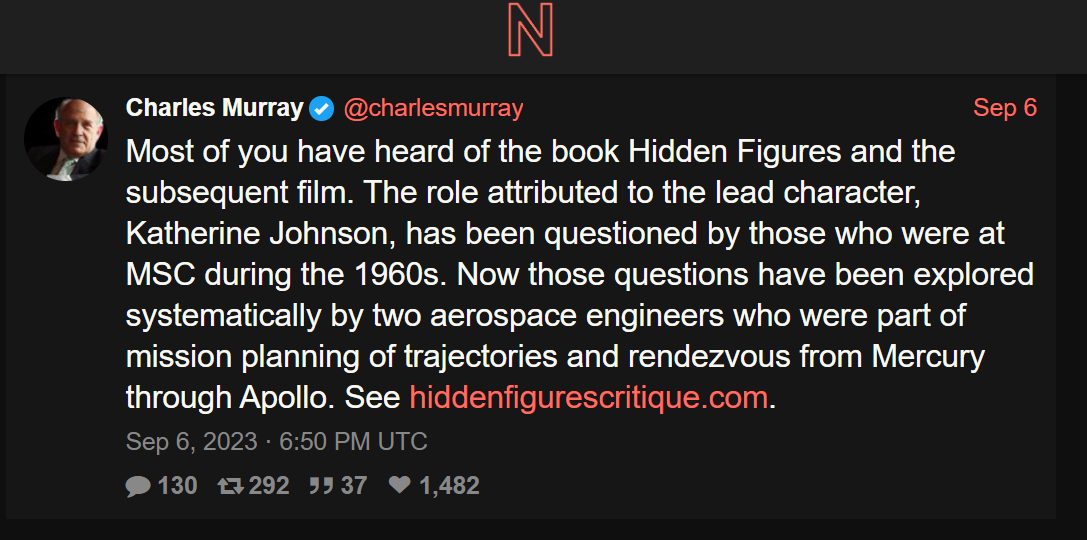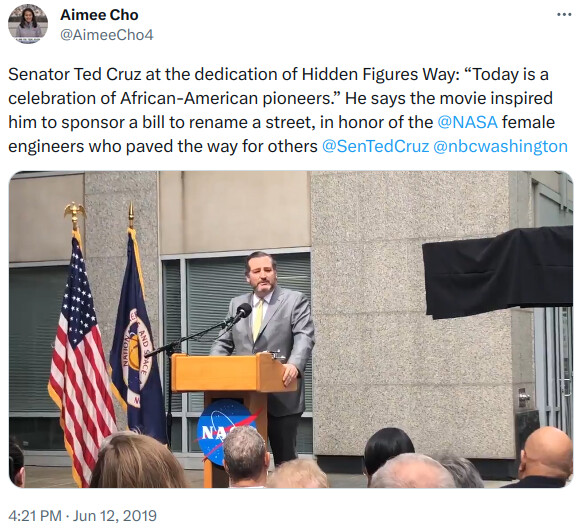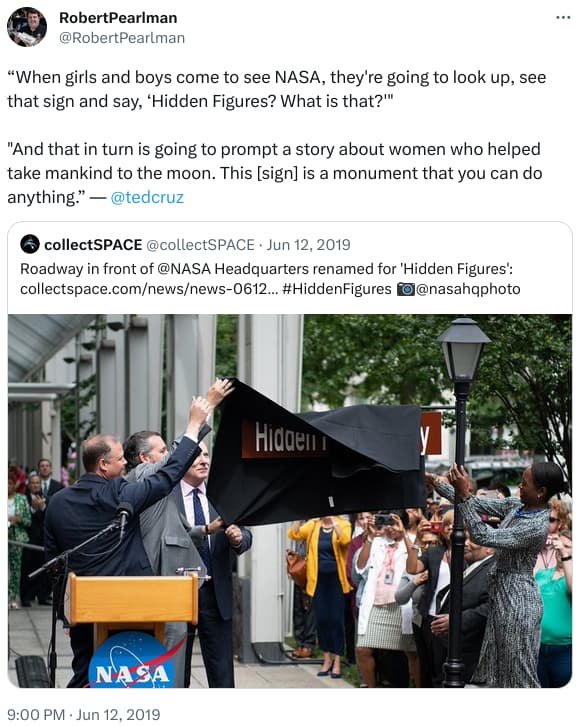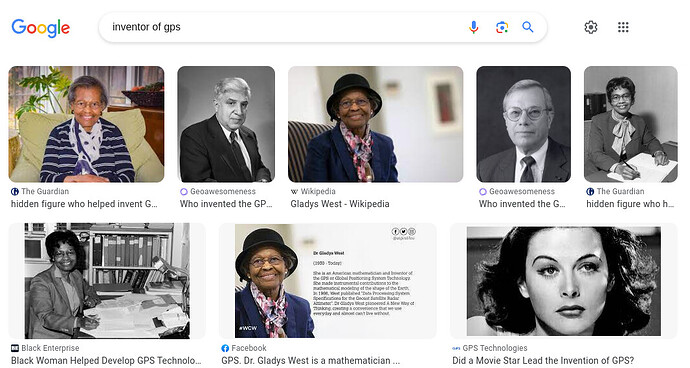Charles Murray (author, with Catherine Bly Cox, of the 1989 book Apollo) is late to the party pointing out the bogosity in Hidden Figures.
Here is one of the first deconstructions of the myth, published at Vdare.com in 2016, “Hyped Figures: John Glenn And The PC Myth Of Katherine Johnson—Unsung Black Women Were NOT What Got Us To The Moon”.
In the book on which the movie is based, Hidden Figures: The American Dream and the Untold Story of the Black Women Mathematicians Who Helped Win the Space Race, by Margot Lee Shetterly, Glenn is quoted as having said this of Katherine Johnson, the black female brain allegedly behind NASA’s greatest glories.
"“Get the girl to check the numbers,” said the astronaut. If she says the numbers are good, he told them, I’m ready to go.”
Glenn was supposedly asking for one more check before his flight into space—a review of the orbital trajectory generated by the IBM 7090 computer.
With Glenn’s death, we will never know if this conversation ever took place. But it is part of an insistent revisionist history of NASA [National Aeronautics and Space Administration], which was in fact almost entirely staffed by whites until the Apollo program was shuttered in the early 1970s.
⋮
But the recent canonization of Katherine Johnson and her “untold” contributions to NASA’s incredible achievements (think about it: the Wright brothers were the first humans to fly in 1903, NASA landed men on the moon only 66 years later) stretches credulity.
- Why isn’t Johnson mentioned in John Glenn’s John Glenn: A Memoir or Alan Shepard’s Moon Shot: The Inside Story of America’s Race to the Moon?
- Why does Charles Murray not mention her in his seminal book on the Apollo program (co-authored with Katherine Murray), Apollo: Race to the Moon?
- Why is Johnson not mentioned in Tom Wolfe’s epic The Right Stuff, documenting the sensational story of NASA’s first astronaut group, the all-white Mercury 7.
- Why, especially oddly, is Johnson not mentioned in We Could Not Fail: The First African Americans in the Space Program.
- Why was Johnson not mentioned in either Jet or Ebony magazine, two black magazines that spent the 1960s and 1970s simultaneously lamenting the lack of blacks at NASA and celebrating any minor achievements of blacks in the space program.
⋮
- Why, given her alleged role in the Apollo 13 drama, does Johnson not appear in Jim Lovell’s autobiographical Lost Moon: The Perilous Voyage of Apollo 13 (subsequently made into the Tom Hanks movie, Apollo 13).
- Why does Gene Kranz, the Flight Director of NASA famously played by Ed Harris in Apollo 13, fail to mention Katherine Johnson in his autobiography Failure is Not an Option: Mission Control from Mercury to Apollo 13 and Beyond?
- Why, perhaps most significantly, does Johnson not appear in Harlem Princess: The Story of Harry Delaney’s Daughter, the autobiography of Ruth Bates Harris? Harris, who took the job of Deputy Assistant Administrator for Equal opportunity for NASA in 1972, famously said, “I saw no minorities or women as astronauts. Could I help make a difference?" Harris waged a war to get more blacks involved with NASA, which was a paltry 5.6 percent non-white in 1973 versus a government agency average of 20 percent minority. [Societal Impact of Spaceflight, 2007, PDF]
- Why does Johnson not appear in Beyond Uhura: Star Trek and Other Memories, by the black actress Nichelle Nichols, who played the part of Lt. Uhura in the iconic TV series Star Trek? Nichols waged a personal crusade against the overwhelming white nature of NASA, giving a speech in 1977, “New Opportunities for the Humanization of Space,” lamenting how white the space agency was and how this was dehumanizing to nonwhites.
⋮
Let’s be honest: the only “revisionist” history going on right now is the push to have Americans in 2016 believe a black woman was key to NASA’s putting a man on the moon.
So effective was the myth-making that the usually sensible junior Senator from Texas was sucked into the vortex of confabulation in 2019.
Now, if an ambitious author and Hollywood wish to concoct a feel-good just-so story about a NACA and NASA employee whose long career spanned the origin of U.S. human space flight, advancing from operating a desktop calculator to writing technical reports on mission trajectory and orbit calculations, inflating her significance totally out of proportion to her actual genuine contributions (while ignoring those of her peers who did not happen to be female and black), well fine—that’s what authors and Hollywood do. But creating a myth that falsifies the historical record (which is exhaustively documented from primary sources, as in “The Portrayal of Early Manned Spaceflight in Hidden Figures: A Critique”, linked in the main post) and causes the made-up story to be replace accounts of what actually happened and the people responsible for these achievements is reprehensible.
While we’re on this topic, try asking the Fountain of Knowledge for images of the “inventor of GPS”.
Who’s the lady who pops up five times in the first eight results? Well, that would be Gladys West, who worked for the Naval Proving Ground (later Naval Surface Warfare Center) in Dahlgren, Virginia from 1956 until 1988, initially as a computer programmer and later as project manager for satellite data analysis. Her work involved processing data from the Seasat and Geosat radar altimetry instruments and using them to develop and refine models of the “geoid”—the shape the ocean would take purely from the Earth’s gravity and rotation (neglecting influences such as tides, wind, and atmospheric pressure). This work culminated in a 1986 technical report, “Data Processing System Specifications for the Geosat Satellite Radar Altimeter”, describing how the satellite data were processed to refine the model of the geoid.
What did this have to do with the invention of the Global Positioning System (GPS)? Nothing: zippo, nada, rien du tout, bupkis, niente, ничего. Development of the Global Positioning System (originally Navstar GPS) system began in 1973 as a U.S. Department of Defense project incorporating aspects of the Navy’s Timation system and Air Force Project 621B. The first GPS satellite was launched in 1978, and the constellation was filled out over the years, becoming fully operational in 1995. But the partially-deployed system was usable well before that, playing a part in the First Gulf War in 1991, where it allowed ground forces to navigate over the trackless desert.
Now, conversion of the signals broadcast by the GPS satellites in orbit into latitude, longitude, and altitude (plus precise time) by a receiver on or above the Earth requires an accurate model of the shape of the Earth, and the geoid is an essential part of that model. The satellite geodesy projects to which Gladys West contributed allowed GPS receivers to perform this task, but were motivated by other applications as well, such as allowing U.S. Navy ballistic missile submarines to hit their targets, and would have been pursued if GPS had never been invented (by people other than Ms. West).
West’s contributions, like those of Katherine Johnson, were largely ignored until after the Great Awokening around 2013, when starting in 2018, recognition and retconning of Gladys West’s rôle in GPS shifted into high gear, as exemplified by the 2021-02-18 Forbes story:
The Guardian, on 2020-11-19, put the “invent GPS” myth right in the title.
The subtitle says “But she didn’t know her quiet work on a naval base would change lives around the world”. Well, that’s right, because she was working on solving problems for the Navy, totally unrelated to GPS, which had already been in development since 1973 and had its first prototype satellite in orbit in 1978, the same year Seasat launched. By the time Geosat launched in 1985, GPS had already launched ten of its Block I satellites, completing Block I deployment, and compatible receivers were under development and testing.
Once again, a solid contributor to a technological project has been singled out and history rewritten to cast her as having done things she never did, while neglecting many whose direct contributions to the creation of GPS were vital to making it a reality.
(Who’s the other lady in the “inventor of GPS” results? That’s Hedy Lamarr, who co-invented the frequency-hopping spread spectrum method for secure communication in 1942 [U.S. Patent 2,292,387 {PDF}], which was a precursor to the spread spectrum transmission method used by GPS as well as Wi-Fi, Bluetooth, and some mobile telephones. Lamarr’s career as an inventor came to an end three decades before the inception of GPS.)
No. She and/or her coinventor came up with the invention of using player piano-type rolls to synchronize the frequency hopping of the two devices. They did not come up with the general concept of frequency hopping. I have not heard anyone provide an explanation of how that invention was anything but a dead end branch.
She lost any limited credibility when they trashed the Navy:
Antheil was later quoted as having said that comparing the mechanism of their invention to a player piano when pitching it to naval officers was probably a bad idea.
“‘My god,’ I can see them saying, ‘we shall put a player piano in a torpedo.’”
Yes—The Hedy Lamarr Wikipedia page notes:
Furthermore, outside of incorporating the use of a miniaturized clockwork piano, their ideas on frequency-hopping were not new. As early as 1899, Guglielmo Marconi had experimented with frequency-selective reception in an attempt to minimize radio interference. The earliest mentions of frequency hopping in open literature are in US patent 725,605, awarded to Nikola Tesla on March 17, 1903, and in radio pioneer Jonathan Zenneck’s book Wireless Telegraphy (German, 1908, English translation McGraw Hill, 1915). And Zenneck notes that Telefunken had already previously implemented it. In 1929, the Polish engineer and inventor Leonard Danilewicz further elaborated on the idea; and, in 1932, U.S. Patent 1869659A was issued to the Dutch inventor William Broertjes for his electromechanical device to encrypt radio transmissions by using frequency-hopping.
and:
It has been reported in many online publications that Antheil and Lamarr’s work helped with the creation of Wi-Fi, Bluetooth, GPS and cellphones, however their work was never formally adopted anywhere.
Until I read that Wikipedia page, I never knew about the litigious Hedy (not Hedley!) Lamarr.
In 1974, she filed a $10 million lawsuit against Warner Bros., claiming that the running parody of her name (“Hedley Lamarr”) in the Mel Brooks comedy Blazing Saddles infringed her right to privacy. Brooks said he was flattered; the studio settled out of court for an undisclosed nominal sum and an apology to Lamarr for “almost using her name”. Brooks said that Lamarr “never got the joke”.
It’s all cultural vandalism all the time. This has been going on for so long that I don’t even care anymore. Let them enjoy their fantasies. They’ll achieve nothing with their mediocrity. Wishing does not make it so.
‘Hedley’ was probably too stupid to get the joke.




